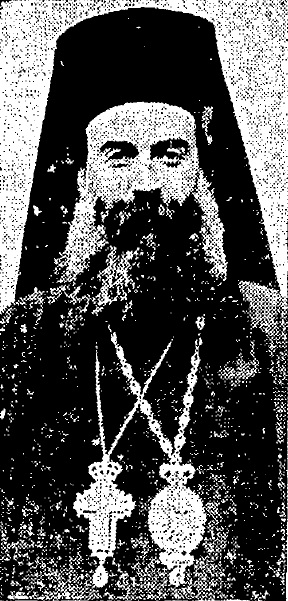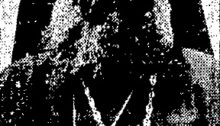
In 1931, the Greek Archdiocese decided to establish a monastery in North Carolina. On October 10, 1931, a Chicago Greek newspaper, the Saloniki-Greek Press, reported this:
The mixed council of the Greek Archdiocese for a long time has contemplated the feasibility of such an institution as the spiritual center for the Greeks in America. Gastonia, North Carolina, has the distinction of having the first Greek monastery in this country. St. Stephen is the name it is given.
The estate is composed of 420 acres and known as Crowder’s Mountain, where formerly was functioning Linwood College. It includes the famous springs known as All Healing Springs. The many buildings of the former college have been transformed and reconstructed for the monastic life of the new occupants. The mild climate and salubriousness of the place makes it an ideal spiritual center.
The estate was bought by the Greek Archdiocese through Greek contributions. New buildings are erected and a new Church is practically completed, as new contributions come in. Bishop Philaretos of San Francisco is in charge of regulating the institution. Thousands of Greeks all over the country who will visit the monastery will have the opportunity to hear the churches’ bells chiming Byzantine music.
1931 was a big year for the Greek Archdiocese, marking the beginning of the era of Archbishop Athenagoras, who reshaped the Archdiocese before becoming Ecumenical Patriarch. According to William Samonides, Archbishop Athenagoras had big plans for the Gastonia site — it would house, not only a monastery, but also a seminary and an orphanage. The biggest donors were Constantine and Stefano Stephano, cigarette magnates from Philadelphia, who put up $12,500 (roughly $200,000 today). The monastery was named in their honor.
This is kind of a tangent, but I can’t resist a story about Constantine Stephano. This guy was a piece of work. In 1912 (so, almost 20 years before this monastery story), Stephano was basically running the show at the Philadelphia Greek church. These were the days before the Archdiocese, and Greek parishes were dominated by parish councils and wealthy laymen. Stephano was a millionaire, even back then, and he expected the priest to be subservient. But the priest in Philadelphia, Fr. Demetrios Petrides, was not about to tolerate that kind of disrespect. Stephano sent this message to Petrides:
Constantine Stephano commands you to appear at his office every evening at sunset and salaam low upon entering his presence. Then you are to stand erect, with folded arms, with your eyes cast downward, awaiting a word from Stephano before sitting down or otherwise changing your position. If you are not asked to be seated you are to remain in this position until Stephano leaves his office, and when he passes through the door you are to salaam low again and depart with bowed head.
Fr. Demetrios replied, “I will not thus humiliate myself before this maker of cigarettes.” Stephano ran Fr. Demetrios out of Philadelphia.
Anyway, that was long before the monastery in Gastonia. Things came together over the next year, and in September 1932, the facility was dedicated and the cornerstone laid by Archbishop Athenagoras. William Samonides reports that 3,000 Greeks were on hand. The priest in charge of the monastery was Fr. Emilianos Paschalakis, parish priest of the Greek church in Charlotte. It appears that the monastery operated for a couple of years, but closed in 1935. In the years that followed, Holy Cross Seminary was established in Boston, and an orphanage, St. Basil’s Academy, near West Point, New York. But no new monastery was established to replace St. Stephen’s.
The author of that Saloniki-Greek Press article I started with, from 1931, envisioned St. Stephen’s as the beginning of a new era of monasticism in America, exclaiming, “Is it possible for the progressive Greek mind to be contented with one monastery for the 500,000 Greek-Americans? No!”
But, well… yes, unfortunately, the progressive Greek mind was not only contented with only one monastery — it was apparently contented with zero. As far as I’m aware, there would not be another Greek monastery in America until the early 1960s, when Holy Transfiguration Monastery was formed in Uniontown, Pennsylvania. It didn’t last the decade, though. There was a short-lived Greek women’s monastery of St. Iakovos, located on the grounds of St. Basil’s Academy — remember, the original orphanage at Gastonia shared land with St. Stephen’s monastery — but St. Iakovos also closed after a short period. According to the indispensable Atlas of American Orthodox Christian Monasteries, by Alexei Krindatch, the oldest Greek Orthodox monastery in America is St. Gregory Palamas, in Ohio, which was established in 1983. [EDIT: A reader named Chris Gorman pointed out that I forgot about Holy Transfiguration Monastery in the Boston area, which was in the Greek Archdiocese from 1960 to 1965, at which point it joined ROCOR. It has since left canonical Orthodoxy and is part of HOCNA — the “Holy Orthodox Church in North America.”]
I don’t know how many monks were part of the monastery, or what happened to them after it closed. In the 1970s, the land became part of the new Crowder’s Mountain State Park, and it sounds like there are still remains of the old Linwood College buildings there — buildings that would have been used by the monastery, as well. I don’t know if there are any distinctively Orthodox buildings or artifacts, but it sounds like this whole story is ripe for additional research.

Leave a Reply